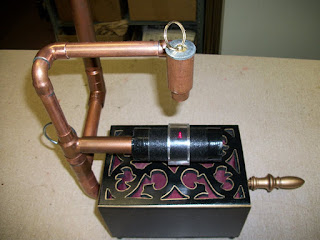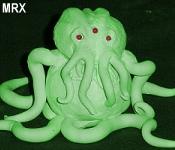I'm back. Origins is finally over and I'm still working on putting my stuff away from the trip, but I have a few minutes to post about some of the new props that I took with me.
The Steampunk Phonograph build was shaping up and nearing completion when I last posted. With the pipe work sorted out and the horn nearly complete, by next big hurdle was the optics. I had decided in the early stages that I wanted to use a laser pointer instead of a traditional stylus. Now I just had to find a way to make one fit. I started by tearing apart a laser pointer to see what I had to work with.
It was harder than I thought. The body of the mechanism and the lens are fused to the casing. I had to cut down the casing with a Dremel to get at the circuit board. Then I de-soldered the momentary contact switch and removed it from the board so I could implement my own switching mechanism. I even had to trim dowm the board a bit to fit the whole thing inside a copper elbow for mounting.
Then, something happened. I stumbled upon a completely mechanical solution, that didn't require any rewiring or dissassembly of the laser pointer (a new one, obviously), and it even looked better than my original plan. A half inch copper pipe fit over the body of the pointer perfectly, and with just crimping the pipe into a slightly oblong shape, twisting the pointer inside the pipe would depress the switch and hold it down. Also, the whole pointer assembly fit perfectly inside a reducer T, and it even looked cool. All I had to do was cut a sleeve of pipe and crimp it, then jam that sleeve inside the reducer T. I had a fender washer that fit the end of the reducer T perfectly, and would keep the pointer in place. The tiny nub where the keychain attaches to the end of the pointer stuck up past the fender washer, which made it perfect for threading a split ring through. The split ring would help to keep the pointer in the right position and also serve as the "switch". By turning the split ring, the whole pointer would turn inside the sleeve and depress the switch. Turn it a little more, and it would turn off. By attaching the fender washer to the reducer T with super glue, I could remove the pointer from the assembly at any time to replace the batteries.
The body of the phonograph was given a black lacquered finish, just like the horn. I used a gold leafing paint pen to trim the edges.
The last piece of the puzzle was the spindle arm, which I had already started a while back. I had originally wanted to make it so that the spindle arm rotated as it played, but that seemed impractical on my time table. It would just have to be stationary. I started with a length of pvc pipe which, coincidentally, fit perfectly onto the end of a copper reducer T. I needed to build up the pipe to the diameter of the cylinder tube, giving it enough of a snug fit that it would hold in place, but not so snug that it would be hard to change tubes. I glued foam padding to the pvc pipe.
Then I covered the foam in velvet cloth. I sewed the velvet into a sleeve and pulled it over the foam. One end of the tube of cloth got glued down to meet the pipe. The other end got tucked into the end of the pipe. a white glass marble fit perfectly into the end of the pipe with the cloth tucked in. It was a nice snug fit. The marble would serve as a decorative piece, and to hold the cloth in place.
I had also decided early on that I wanted a sort of "floating" acrylic ring around the cylinder The laser would shine through the ring, as sort of a lens. I'm not really sure why, I wanted it, I just thought it would look neat, and kind of futuristic. It sold the idea of a laser stylus better than just having the laser hitting the bare surface of the cylinder, imho.
Mounting the acrylic ring so that it seemed to float over the cylinder was a bit of a challenge. I pondered several design approaches before settling on a thin metal arm for the ring to be attached to. I had some left over chromed rod from my Steampunk Diving Helmet project that would fit the bill. I cut it to length, and epoxied it to the ring, by carving a small groove in the acrylic with a Dremel. This gave the epoxy more to grab hold of. Then I attached the rod to one of the reducer Ts with a copper strap and more epoxy. I kept the spacing constant by using chipboard shims until the epoxy was dry.
My plan to use the screw and washer assembly to mount the horn to the pipe-works needed a little fine tuning. First it needed a longer screw, and a slightly different selection of washers.
Then I needed to cut a custom wooden plug that would fit snugly inside the pvc elbow. I got as close as I could to the right diameter with my hole cutting drill bit (for cutting holes in doors for lock assemblies). Then I had to improvise a power sander using a sanding block and a drill press to shave it down to the perfect size.
Once it was the perfect diameter, I had to make countersinks on each side for the nuts, one that would be epoxied to this piece and one that would remain on the screw, holding the washer assembly together on the horn.
Then the plug was epoxied to the inside of the pvc elbow. After it was dry, I could unscrew the elbow from the horn, without affecting the washer assembly, allowing for easier storage and transport.
The last detail to be completed before final assembly was the speaker grill and sound system. I bought a small battery powered speaker set from a discount store for $1.50. It is designed to be used with mp3 players. I also picked up a simple mp3 player for about $20. Both would fit inside the body of the phonograph, or, to eliminate having to open the lid to change the song, I could put the mp3 player underneath the body, attaching the wire through a hold in the bottom, and just slide it out to change the song, and then slide it back under again to hide it. I loaded up the mp3 player with some classical music for the LARP, but it can play anything.
The speakers would be hidden by the fretwork on the lid, which would also let the sound come through. It is a little muffled, but still audible. To completely hide the inner workings, I added a thin piece of satin fabric to the underside of the lid, held in place by a piece of foamcore.
A word about the pipe-works; The majority of it is made form copper plumbing pipe. Some of it is made from pvc pipe and painted to match. Marching the color was hard. Copper has a wide range of colors, from pinkish, to dark orange-brown. Just to make the copper pieces all match each other, I had to wash them in HCL acid and scrub them with a scotch brite pad. Then when they reached the color I wanted, I sprayed them with clear coat to prevent further oxidation. Then I had to use several enamel and acrylic paints to get the pvc to match it. I got as close as I could. I have about a half dozen "copper" paints, but none of them ever seem to look like real copper.
Some of the pipes were soldered together, and some were not. This allows for disassembly for transport and storage, as well as some room for adjustments to the position of the horn, cylinder and stylus arms. I also needed to be able to swing the stylus and cylinder arms away to open the lid of the body and get to the speakers and mp3 player. I learned the hard way to swing them forward, not back, or the whole thing will be rear-heavy and tip backwards.
That's pretty much it for construction. This build was complicated in so far as it had a lot of little technical details to be tackled. But it was far easier than the Steampunk Diving Helmet project. It would have been harder if I had not used a pre-fab box as the body.
Here are some glamor shots of the finished assembly. BTW, I did end up putting the wire grill in the horn during the show, but it looks just as good without it. Some of the pics here show it with and some show it without.
See also:
Steampunk Phonograph (pt.1)
Steampunk Phonograph (pt.2)
Steampunk Phonograph (pt.3)
Phonograph Prop Redux
Sunday, July 3, 2011
Subscribe to:
Post Comments (Atom)






















































A thing of beauty indeed, interesting watching the build, well done that man.
ReplyDeleteThis is amazing well done!!
ReplyDelete